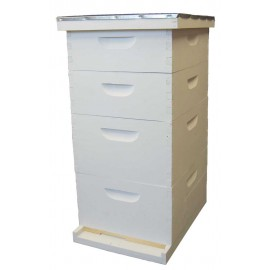Building Your Beehive

Building Your Hive
You’ve done your studying, and you have a pretty good idea of what is involved in becoming a beekeeper. As a result, you have decided to give it a try. Great! The next step is to build out your beehive. It may sound like a quick decision to make, but it is not that easy. Next to where you decide to place your hive, the type of hive you choose to build is significant.
As mentioned in our previous article, it is not suggested that you buy a used hive. If the used hive has not been cleaned properly, your bees are susceptible to coming down with foulbrood—more specifically, American foulbrood. The disease itself is caused by a spore-forming bacteria and is highly infectious by nature. This disease can wipe out the entire hive in little to no time at all. American foulbrood is believed to be the most widespread and destructive of the bee brood diseases.
We have established that your best choice will be that of building a new, clean, unused hive. There are many types of hives and parts that go into them, however in this article we are going to look at the different components needed to build your hive.
When it comes to the actual hive, where the bees will live and work, there are four necessary components. We will take a look at each of those components below.
Frame
The frame of the hive, or the honey frame as it is most commonly referred to, is a structure within the hive that has the purpose of holding the honeycomb, often referred to as the comb, and said before is contained within the hive enclosure or box itself. This frame is removable providing the beekeeper with the ability to either inspect the hive for disease or for the process of removing the honey.
Super Honey supers are generally available in two different sizes. The shallow version measures 5 ¾ inches deep, and the medium version measures 6 5/8 deep. The shallow version is capable of holding up to 10 shallow frames per box, whereas the medium super is capable of accommodating up to 10 medium frames per box.
Brood Box
This is usually your box on the very bottom of the hive. Also known as the “brood chamber,” this portion of the hive contains the worker-made cells that house the eggs, and where the larvae and pupae develop. Some of the cells in this portion of the hive are commonly relegated to holding pollen, nectar, or honey. This is basically the food supply for use by the developing larvae. It is suggested that the rule of thumb is to use one and no more than two brood boxes at any given time. It is believed to be a disservice to your hive to use more than two. If you find the need for three, you would be better off splitting the hive.
When it comes to the actual number of frames to use in a brood box, typically up to ten can be used. However, once the hive is built up and well-populated, ten will be a pretty tight fit. It is best to go with the more common nine frames.
It is worth noting that you are able able to extract honey from a brood frame—keeping in mind that there can be no brood currently calling the frame home.
Bottom Boards
The bottom board on a beehive serves as the base, or platform, on which the other components that make up the hive rests. It is also through the bottom boards that the bees enter and exit the hive as needed.
The purpose of a bottom board on a hive is two-fold. The main bottom board is to help with the sealing of the hive, so that it may remain protected from the elements. And with a screened bottom board, the intention is to make sure that hive receives the proper amount of ventilation. In areas that experience warm climates, the screened bottom board is a crucial feature.
The Hive Cover
There are actually two covers to a hive. The inner cover goes on the uppermost honey super. This inner cover contains two holes—one is an outside entrance hole, and one hole is in the middle. The cover also has two sides, each with a particular use. One side will be for the winter months, while the other side will be used the rest of the year. It is essential to know that the inner cover plays a vital role in the ability of adequately manipulating the hive.
The outer cover’s purpose is just as the name implies. It rests above the inner cover and serves to cap off the hive. The most commonly used type is that of the telescoping cover, as it hangs down snugly over the top super. This is the most favored cover, as most are made of metal and serve and offer a weather-resistant fit.
Lastly, there is another component, usually seperate from the main hive but can be very helpful to have on hand.
Nuc Boxes
Nuc boxes, or more specifically Nucleus boxes, are used for the main purpose to hive a small bee colony—in most cases a package, a swarm or even a split. Other uses for a Nuc box can include:
• Securely holding the inner frames while performing an inspection of the bee hive or to redistribute the enclosed resources.
• In the case of swarms, can be used as a bait box
• It can be used in the raising of bee queens
• In some cases, a Nuc can be utilized as housing for a battery to power an electric fence for your bee yards.
In the case of a Double Nuc, beekeepers have an excellent benefit to help minimize their continued reliance on packaged bees. The beekeeper has the option of preparing the nucs during the summer and then overwinter them. This offers the options of having nucs on hand to offer for sale, or the use for the next spring. Bees overwinter winter well in a the properly configured frame.
These are the basic components needed when constructing your beehive. Once you get your basic hive built and established, as with any construction, you have the option of just a few honey supers, or you can keep adding them on. It is really up to you on how big you want to go with your hive. However, it is always advised not to go too big, but instead to split the hive.
Check out some of our great products at https://petricbees.com/sale for the many options on how you can get started in beekeeping.
